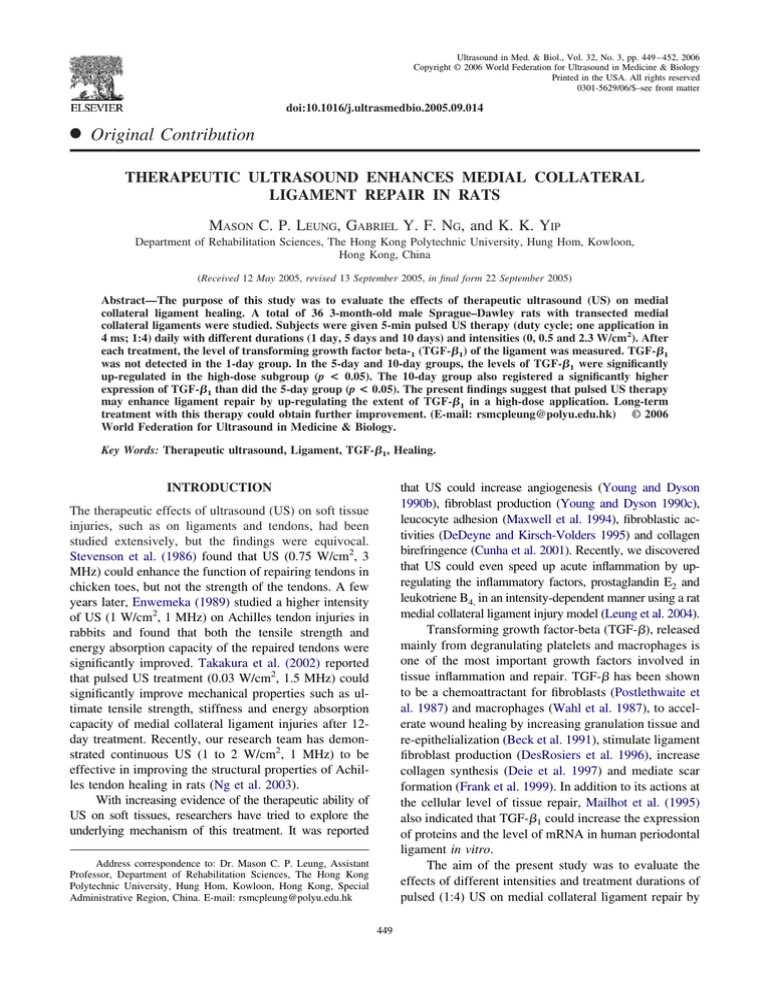
Ultrasound in Med. & Biol., Vol. 32, No. 3, pp. 449 – 452, 2006
Copyright © 2006 World Federation for Ultrasound in Medicine & Biology
Printed in the USA. All rights reserved
0301-5629/06/$–see front matter
doi:10.1016/j.ultrasmedbio.2005.09.014
● Original Contribution
THERAPEUTIC ULTRASOUND ENHANCES MEDIAL COLLATERAL
LIGAMENT REPAIR IN RATS
MASON C. P. LEUNG, GABRIEL Y. F. NG, and K. K. YIP
Department of Rehabilitation Sciences, The Hong Kong Polytechnic University, Hung Hom, Kowloon,
Hong Kong, China
(Received 12 May 2005, revised 13 September 2005, in final form 22 September 2005)
Abstract—The purpose of this study was to evaluate the effects of therapeutic ultrasound (US) on medial
collateral ligament healing. A total of 36 3-month-old male Sprague–Dawley rats with transected medial
collateral ligaments were studied. Subjects were given 5-min pulsed US therapy (duty cycle; one application in
4 ms; 1:4) daily with different durations (1 day, 5 days and 10 days) and intensities (0, 0.5 and 2.3 W/cm2). After
each treatment, the level of transforming growth factor beta-1 (TGF-1) of the ligament was measured. TGF-1
was not detected in the 1-day group. In the 5-day and 10-day groups, the levels of TGF-1 were significantly
up-regulated in the high-dose subgroup (p < 0.05). The 10-day group also registered a significantly higher
expression of TGF-1 than did the 5-day group (p < 0.05). The present findings suggest that pulsed US therapy
may enhance ligament repair by up-regulating the extent of TGF-1 in a high-dose application. Long-term
treatment with this therapy could obtain further improvement. (E-mail: rsmcpleung@polyu.edu.hk) © 2006
World Federation for Ultrasound in Medicine & Biology.
Key Words: Therapeutic ultrasound, Ligament, TGF-1, Healing.
that US could increase angiogenesis (Young and Dyson
1990b), fibroblast production (Young and Dyson 1990c),
leucocyte adhesion (Maxwell et al. 1994), fibroblastic activities (DeDeyne and Kirsch-Volders 1995) and collagen
birefringence (Cunha et al. 2001). Recently, we discovered
that US could even speed up acute inflammation by upregulating the inflammatory factors, prostaglandin E2 and
leukotriene B4, in an intensity-dependent manner using a rat
medial collateral ligament injury model (Leung et al. 2004).
Transforming growth factor-beta (TGF-), released
mainly from degranulating platelets and macrophages is
one of the most important growth factors involved in
tissue inflammation and repair. TGF- has been shown
to be a chemoattractant for fibroblasts (Postlethwaite et
al. 1987) and macrophages (Wahl et al. 1987), to accelerate wound healing by increasing granulation tissue and
re-epithelialization (Beck et al. 1991), stimulate ligament
fibroblast production (DesRosiers et al. 1996), increase
collagen synthesis (Deie et al. 1997) and mediate scar
formation (Frank et al. 1999). In addition to its actions at
the cellular level of tissue repair, Mailhot et al. (1995)
also indicated that TGF-1 could increase the expression
of proteins and the level of mRNA in human periodontal
ligament in vitro.
The aim of the present study was to evaluate the
effects of different intensities and treatment durations of
pulsed (1:4) US on medial collateral ligament repair by
INTRODUCTION
The therapeutic effects of ultrasound (US) on soft tissue
injuries, such as on ligaments and tendons, had been
studied extensively, but the findings were equivocal.
Stevenson et al. (1986) found that US (0.75 W/cm2, 3
MHz) could enhance the function of repairing tendons in
chicken toes, but not the strength of the tendons. A few
years later, Enwemeka (1989) studied a higher intensity
of US (1 W/cm2, 1 MHz) on Achilles tendon injuries in
rabbits and found that both the tensile strength and
energy absorption capacity of the repaired tendons were
significantly improved. Takakura et al. (2002) reported
that pulsed US treatment (0.03 W/cm2, 1.5 MHz) could
significantly improve mechanical properties such as ultimate tensile strength, stiffness and energy absorption
capacity of medial collateral ligament injuries after 12day treatment. Recently, our research team has demonstrated continuous US (1 to 2 W/cm2, 1 MHz) to be
effective in improving the structural properties of Achilles tendon healing in rats (Ng et al. 2003).
With increasing evidence of the therapeutic ability of
US on soft tissues, researchers have tried to explore the
underlying mechanism of this treatment. It was reported
Address correspondence to: Dr. Mason C. P. Leung, Assistant
Professor, Department of Rehabilitation Sciences, The Hong Kong
Polytechnic University, Hung Hom, Kowloon, Hong Kong, Special
Administrative Region, China. E-mail: rsmcpleung@polyu.edu.hk
449
450
Ultrasound in Medicine and Biology
measuring the expressions of the most abundant isoform,
TGF-1 in a rat ligament injury model.
METHODS
Animals
A total of 36 3-month-old male Sprague–Dawley
rats were used. The handling of the animals complied
with the Code of Ethic of Animal Subjects in our university. A total of three treatment times and three US
intensities were studied. Each knee of the animals was
randomly allocated to a group, as shown in Table 1.
Injury protocol
The injury method replicates that of our previous
study (Leung et al. 2004). In brief, the animals were anesthetized with an IP injection of a mixture of 70 mg/kg
ketamine (Alfasan International, Woerden, The Netherlands) and 7 mg/kg xylazine (Alfasan). The middle part of
the medial collateral ligament of both knee joints was
transected. The skin wound was then closed with sutures.
Ultrasound therapy
After surgery, all the rats were given 5 min of US
therapy (Enraf-Nonius, Sonopuls #434, The Netherlands)
daily by means of the water-immersion method under general anesthesia. Pulsed US (duty cycle; 1 application in 4
ms; 1:4) at 3-MHz frequency was applied with different
intensities: 0 W/cm2, 0.5 W/cm2 and 2.3 W/cm2 to both
legs of the animals, according to their group assignments as
per Table 1. The intensities chosen covered both low-dose
and high-dose low-intensity US. The animals in the 1-day
group received US on postinjury day 1; the animals in the
5-day group started to receive US from postinjury day 1 to
5; and the animals in the 10-day group received US from
postinjury day 1 to 10.
Sample preparation
At 1 day after the completion of US treatment, the
rats were euthanized by an overdose of xylazine/ketamine injection. The ligament was harvested, weighed
and immersed in 20 mM Tris-HCl in pH 7.4 with 1:2
dilution (1 g tissue: 2 mL buffer). The mixture was then
homogenized. The homogenate was centrifuged at 4 °C
with 12,000 rpm for 30 min. The supernatant was used
for measuring the level of TGF-1.
Volume 32, Number 3, 2006
TGF-1 assay
TGF-1 was examined by the TGF-1 assay kit (Promega TGF-1 Emax™ ImmunoAssay System, Madison,
WI, USA). The supernatant was acid-pretreated and diluted
by adding 4 volumes of Dulbecco phosphate-buffered saline (DPBS; 0.5 g KCl/8 g NaCl/0.2 g KH2PO4/1.15 g
Na2HPO4/133 mg CaCl2.2 H2O/100 mg MgCl2.6 H2O in 1
L, pH 7.35), then acidified to approximately pH 2.6 by
adding 1 L of 1 N HCl to each 50 L of diluted sample.
After 15 min of incubation at room temperature, the acidified supernatant was neutralized back to pH 7.6 by adding
1 L of 1 N NaOH. After that, 10 L of TGF--coated
mAb was added to 10 mL carbonate-coating buffer (0.025
mol/L sodium bicarbonate/0.025 mol/L sodium carbonate,
pH 9.7). The plate was coated with 100 L of this mixture
and then incubated overnight at 4 °C. After incubation, the
plate was allowed to reach room temperature. The coating
buffer was removed by flicking out of the wells. Then, 270
L of TGF- Block 1 X buffer was added to each well at
37 °C for 35 min. After blocking, the wells were washed 3
times with Tris-buffered saline Tween-20 (TBST) washing
buffer (20 mM Tris-HCl, pH 7.6/150 mM NaCl/0.05%
(v/v) Tween®20) to remove unnecessary blocking. A total
of 100 L of acid-pretreated sample was pipetted into each
well and incubated at 37 °C for 90 min. The wells were then
washed with TBST washing buffer 5 times. Then, 100 L
of 1:1000 diluted TGF-1 protein antibody (pAb) was
added to each well to bind the TGF-1 and incubated for 2 h
at room temperature. After washing 5 times with TBST
washing buffer, 100 L of 1:2000 TGF- horseradish peroxidase conjugate was added to each well to bind to the
TGF- antibody pAb. The plate was shaken for 2 h at room
temperature. The wells were then washed 5 times with
TBST and 100 L of enzyme substrate (5 mL of 3,3⬘,
5,5⬘-tetramethylbenzidene (TMB) solution/5 mL of peroxidase substrate) was pipetted into each well and the plates
left to incubate for 15 min at room temperature until the
solution in the wells turned blue. The reaction was stopped
by the addition of 100 L of 1 mol/L phosphoric acid to
each well. A yellow color was formed because of acidification. The absorbance at 450 nm was subsequently read by
a microplate reader (Bio-tek Instrument, Inc., Winooski,
VT, USA).
Table 1. The grouping of the animals
Groups
1-day Group*
5-day Group†
10-day Group‡
Control
Low-dose
High-dose
n ⫽ 8, 0 W/cm2
n ⫽ 8, 0.5 W/cm2
n ⫽ 8, 2.3 W/cm2
n ⫽ 8, 0 W/cm2
n ⫽ 8, 0.5 W/cm2
n ⫽ 8, 2.3 W/cm2
n ⫽ 8, 0 W/cm2
n ⫽ 8, 0.5 W/cm2
n ⫽ 8, 2.3 W/cm2
* 1-day treatment, euthanized at day 2; † 5 days treatment, euthanized at day 6; ‡ 10 days treatment, euthanized at day 11.
Ultrasound for ligament repair in rats ● M. C. P. LEUNG et al.
Statistical analysis
All values were presented as mean ⫾ SE. Comparison of the expression of TGF-1 between different intensities of US was performed by one-way ANOVA.
Independent t-test was applied in comparing the same
intensity with different treatment groups. The p value of
⬍ 0.05 was considered to be significant. All statistical
procedures were performed using SPSS version 11.0
(SPSS, Inc., Chicago, IL, USA).
RESULTS
The 1-day group
In the 1-day group, the level of TGF-1 in most US
intensity subgroups could not be detected. This may be
related to the extreme early expression of this growth
factor in ligament healing. Previous studies (Martin et al.
1993) showed that TGF-1 mRNA and protein were
found to be expressed only transiently after injury, from
postinjury hour 1 to hour 18.
The 5-day and 10-day groups
In Fig. 1, TGF-1 in both the 5-day and 10-day
groups was significantly higher in the high-dose subgroup than the control and low-dose subgroups (p ⬍
0.05). When comparing the same intensity subgroups
with different treatment days, a significant increase could
451
be detected in the 10-day group, especially in the highdose subgroup (p ⬍ 0.05). The above findings suggest
that TGF-1 was able to increase by high-dose pulsed US
(2.3 W/cm2). Therefore, it is also surmised that a longterm and high-dose application could further up-regulate
the extent of ligament TGF-1.
DISCUSSION
From our findings, no increase in TGF-1 in the
1-day group was detected. This may be caused by the
expression of this growth factor in an extremely early
manner, because it was reported in previous studies
(Martin et al. 1993) that TGF-1 mRNA and protein
were found to be expressed only transiently after injury,
from postinjury hour 1 to hour 18.
In the 5-day and 10-day groups, US could significantly
up-regulate the expression of TGF-1, especially in highdose subgroups, but not in low-dose subgroups (Fig. 1).
This positive finding illustrated the cellular contribution of
US in tissue recovery apart from improving the physical
properties of soft tissues (Stevenson et al. 1986; Enwemeka
1989; Takakura et al. 2002; Ng et al. 2003).
Soft tissue repair consists of three overlapping
stages, acute inflammation, proliferation and remodeling.
During inflammation, because TGF-1 can attract macrophages (Wahl et al. 1987), its up-regulation by US, as
Fig. 1. Effects of US treatment of different intensities and duration on the level of TGF-1. Data are mean ⫾ SE. In the
5-day and 10-day groups, TGF-1 was significantly increased in their respective high-dose groups. A 10-day treatment
duration could further significantly up-regulate the extent of TGF-1 if high-dose US was applied. *p ⬍ 0.05 compared
with high-dose group; † p ⬍ 0.05 compared between intensity groups.
452
Ultrasound in Medicine and Biology
shown in the present study, could speed up acute inflammation. This interpretation was demonstrated in our previous report (Leung et al. 2004) that found US could flare
up inflammation by increasing the expression of inflammatory factors, prostaglandin E2 and leukotriene B4.
In the proliferation stage, cells are attracted to the
wound site and develop into granulation tissue. Granulation tissue is highly cellular, containing macrophages,
fibroblasts, endothelial cells, fibronectin, type III collagen and hyaluronic acid. Fibroblasts are the main collagen producers for connective tissues and are responsible
for wound contraction. A rise in TGF-1 could stimulate
fibroblast chemotaxis (Postlethwaite et al. 1987), fibroblast production (DesRosiers et al. 1996) and granulation
tissue proliferation (Beck et al. 1991).
In the remodeling phase, type III collagen is replaced
by type I. This process continues until the collagen pattern
and tissue mechanical characteristics gradually simulate the
normal tissue. However, this ideal state may never be
achieved in scar tissue. US could not only up-regulate
collagen birefringence on rat Achilles tendons, revealing
better organization and aggregation of collagen bundles
(Cunha et al. 2001), but could also increase TGF-1 expression, as shown in the present study, which can retard the
scar-formation process (Frank et al. 1999).
When comparing the same intensity subgroups with
different treatment days, the most significant increase
was evident in the high-dose subgroup (2.3 W/cm2). This
indicates a directly proportional relationship between
treatment duration/intensity and expression of TGF-1 as
exemplified by the results obtained from the 10-day
group. However, previous US studies reported that longterm application of US may not provide favorable results
in tissue healing. Young and Dyson (1990a) studied two
timings (5 days and 7 days) of US treatment (0.1 W/cm2,
0.75 MHz and 3 MHz, 5-min daily)on the rat skin wound
and reported a significant increase in the number of
blood vessels only in the 5-day group, not in the 7-day
group. More recently, Takakura et al. (2002) studied the
effects of pulsed US (0.03 W/cm2, 20-min daily) on the
healing of medial collateral ligament in rats at 12- and
21-day intervals. They found that, in the 12-day treatment group, mechanical properties such as ultimate load,
stiffness and energy absorption were significantly superior to those of the control group. However, the 21-day
group indices were not different from those of the control
group. The difference between our findings and those of
the previous studies on tissue recovery may be dosebased. High-dose US may demonstrate a desirable outcome in tissue healing, as shown in the present study,
particularly in long-term use.
Volume 32, Number 3, 2006
CONCLUSION
The present findings indicate that pulsed US could
enhance ligament healing by up-regulating the expression of TGF-1 in high-dose application. Long-term and
high-dose treatment could achieve further improvement.
Acknowledgements—This work was supported by a Faculty Area of
Strategic Development grant (A106) from the Department of Rehabilitation Sciences, The Hong Kong Polytechnic University. The authors
thank Ms. Christine Van for editing.
REFERENCES
Beck LS, Deguzman L, Lee WP. TGF-beta 1 accelerates wound healing: reversal of steroid-impaired healing in rats and rabbits. Growth
Factor 1991;5:294 –304.
Cunha A, Parizotto NA, Vidal BC. The effect of therapeutic ultrasound
on repair of the Achilles tendon (tendo calcaneus) of the rat.
Ultrasound Med Biol 2001;27:1691–1696.
DeDeyne PG, Kirsch-Volders M. In vitro effects of therapeutic ultrasound on the nucleus of human fibroblasts. Phys Ther 1995;75:
629 – 634.
Deie M, Marui T, Allen CR, et al. The effects of age on rabbit MCL
fibroblast matrix synthesis in response to TGF-1 or EGF. Mech
Ageing Dev 1997;97:121–130.
DesRosiers EA, Yahia L, Rivard Ch. Proliferative and matrix synthesis
response of canine anterior cruciate ligament fibroblasts submitted
to combined growth factors. J Orthop Res 1996;14:200 –208.
Enwemeka CS. The effects of therapeutic ultrasound on tendon healing. A biomechanical study. Am J Phys Med Rehab 1989;68:283–
287.
Frank C, Shrive N, Hiraoka H, et al. Optimisation of the biology of soft
tissue repair (Review). J Sci Med Sport 1999;2:190 –210.
Leung MCP, Ng GYF, Yip KK. Effect of ultrasound on acute inflammation of transected medial collateral ligaments. Arch Phys Med
Rehab 2004;85:963–966.
Mailhot JM, Schuster GS, Garnick JJ, et al. Human periodontal ligament and gingival fibroblast response to TGF-1 stimulation. J Clin
Periodontol 1995;22:679 – 685.
Martin P, Dickson MC, Millan FA, Akhurst RJ. Rapid induction and
clearance of TGF beta 1 is an early response to wounding in the
mouse embryo. Dev Genet 1993;14:225–238.
Maxwell L, Collecut T, Gledhill M, et al. The augmentation of leucocyte adhesion to endothelium by therapeutic ultrasound. Ultrasound
Med Biol 1994;20:383–390.
Ng COY, Ng GYF, See EKN, Leung MCP. Therapeutic ultrasound
improves the strength of Achilles tendon repair in rats. Ultrasound
Med Biol 2003;29:1501–1506.
Postlethwaite AE, Keski-Oja J, Moses HL. Stimulation of the chemotactic migration of human fibroblasts by transforming growth factor
beta. J Exp Med 1987;165:251–256.
Stevenson JH, Pang CY, Lindsay WK, Zuber RM. Functional, mechanical and biochemical assessment of ultrasound therapy on tendon
healing in the chicken toe. Plast Reconstr Surg 1986;77:965–970.
Takakura Y, Matsui N, Yoshiya S, et al. Low-intensity pulsed ultrasound enhances early healing of medial collateral ligament injuries
in rats. J Ultrasound Med 2002;21:283–288.
Wahl SM, Hunt DA, Wakefield LM, et al. Transforming forming
growth factor type  induces monocyte chemotaxis and growth
factor production. Proc Natl Acad Sci USA 1987;84:5788 –5792.
Young SR, Dyson M. Effect of therapeutic ultrasound on the healing of
full-thickness excised skin lesions. Ultrasonics 1990a;28:175–180.
Young SR, Dyson M. The effect of therapeutic ultrasound on angiogenesis. Ultrasound Med Biol 1990b;16:261–269.
Young SR, Dyson M. Macrophage responsiveness to therapeutic ultrasound. Ultrasound Med Biol 1990c;16:809 – 816.

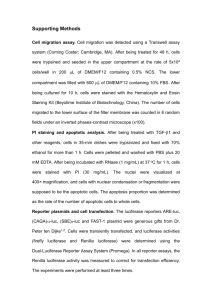
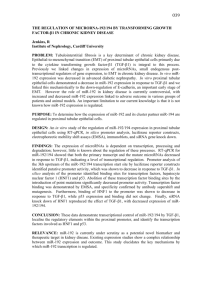
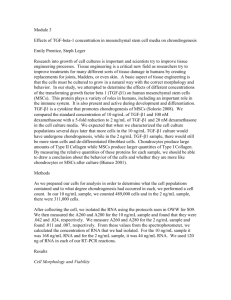

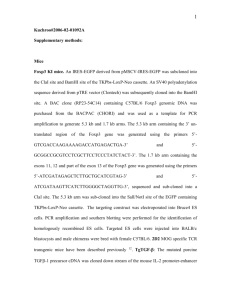
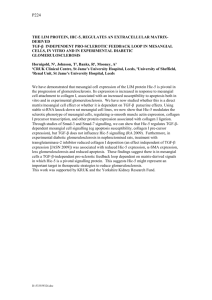
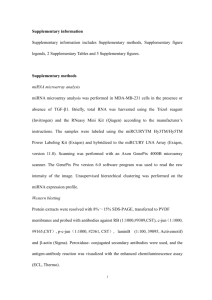
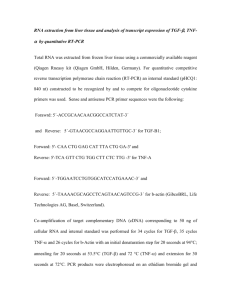

![Jiye Jin-2014[1].3.17](http://s2.studylib.net/store/data/005485437_1-38483f116d2f44a767f9ba4fa894c894-300x300.png)